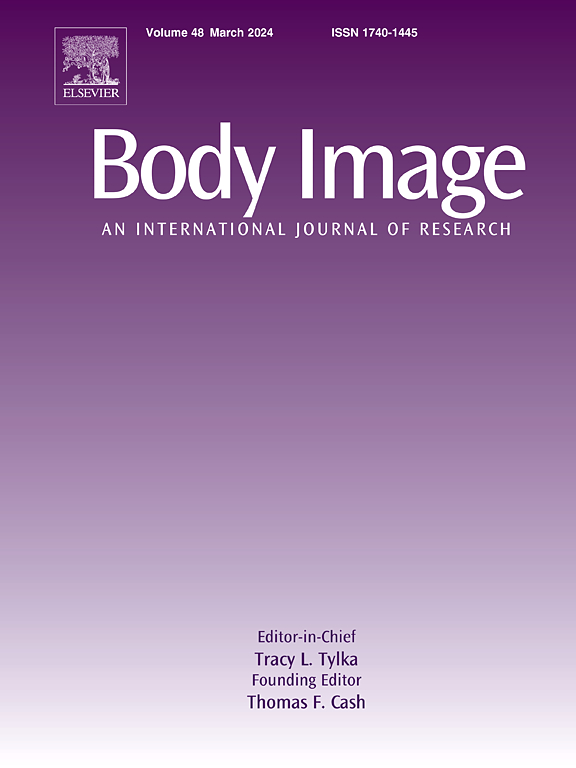Obstacles to forming a positive body image and strategies for overcoming them: A qualitative study of nonbinary individuals’ experiences
IF 5.4
1区 心理学
Q1 PSYCHIATRY
引用次数: 0
Abstract
Although limited research has explored body image trajectories (i.e., how body image evolves across time) among gender-diverse populations, previous studies suggest that nonbinary individuals have distinctive experiences with forming and maintaining positive body image. Moreover, nonbinary individuals, like members of other stigmatized groups, experience unique stressors tied to their marginalized gender identity, though no prior studies have investigated the role of minority stress in positive body image trajectories. The present study employs the gender minority stress framework to explore the obstacles nonbinary individuals face in forming positive body image and the coping strategies foundational to their resilience. We conducted a reflexive thematic analysis of in-depth, semi-structured interviews with 15 nonbinary individuals who scored high on a validated measure of positive body image (the Body Appreciation Scale-2). The analysis revealed eight key obstacles participants encountered as they sought to form a positive body image, such as confining and dangerous anti-LGBTQ+ narratives, gender dysphoria, and familial expectation and religious beliefs. Participants leveraged six coping strategies, such as seeking therapy, resisting comparisons, and nurturing inner kindness and self-consideration to overcome the obstacles they faced. Further, results illustrate how intersectionality with nonbinary identities (e.g., having health concerns or disabilities) creates distinct barriers to positive body image, thereby necessitating a unique, intertwining array of coping strategies. Together, these findings offer a valuable foundation to direct the creation of programs and interventions seeking to build positive body image in nonbinary populations and emphasize the need for diverse samples in positive body image research.
形成积极身体形象的障碍及其克服策略:非二元个体经验的定性研究
尽管对不同性别人群的身体形象轨迹(即身体形象如何随时间演变)的研究有限,但先前的研究表明,非二元个体在形成和维持积极身体形象方面有着独特的经历。此外,非二元个体,像其他被污名化群体的成员一样,经历着与他们被边缘化的性别认同相关的独特压力源,尽管之前没有研究调查过少数群体压力在积极的身体形象轨迹中的作用。本研究采用性别少数压力框架探讨非二元性别个体在形成积极身体形象时所面临的障碍及其应对策略。我们对15名在积极身体形象(身体欣赏量表-2)的有效测量中得分较高的非二元个体进行了深入的半结构化访谈,并进行了反身性主题分析。该分析揭示了参与者在寻求形成积极的身体形象时遇到的8个主要障碍,比如限制和危险的反lgbtq +叙事、性别焦虑、家庭期望和宗教信仰。参与者利用六种应对策略,如寻求治疗,抵制比较,培养内心的善良和自我考虑来克服他们面临的障碍。此外,研究结果还说明了与非二元身份(例如,有健康问题或残疾)的交叉性如何对积极的身体形象造成明显的障碍,因此需要一种独特的、相互交织的应对策略。总之,这些发现为指导在非二元人群中建立积极身体形象的项目和干预措施的创建提供了有价值的基础,并强调了积极身体形象研究中多样化样本的必要性。
本文章由计算机程序翻译,如有差异,请以英文原文为准。
求助全文
约1分钟内获得全文
求助全文
来源期刊

Body Image
Multiple-
CiteScore
8.70
自引率
28.80%
发文量
174
期刊介绍:
Body Image is an international, peer-reviewed journal that publishes high-quality, scientific articles on body image and human physical appearance. Body Image is a multi-faceted concept that refers to persons perceptions and attitudes about their own body, particularly but not exclusively its appearance. The journal invites contributions from a broad range of disciplines-psychological science, other social and behavioral sciences, and medical and health sciences. The journal publishes original research articles, brief research reports, theoretical and review papers, and science-based practitioner reports of interest. Dissertation abstracts are also published online, and the journal gives an annual award for the best doctoral dissertation in this field.
 求助内容:
求助内容: 应助结果提醒方式:
应助结果提醒方式:


